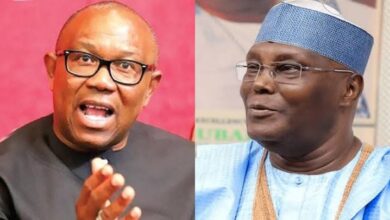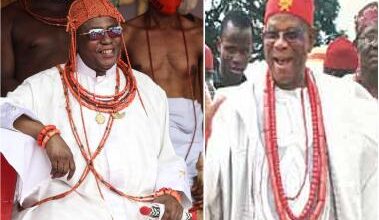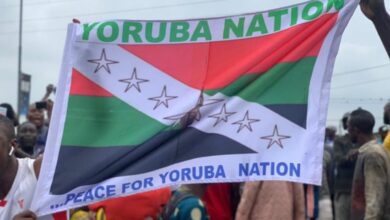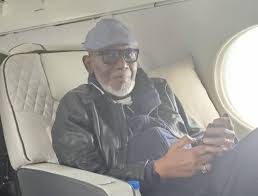Most West Niger Igbo Originated From Ile-Ife and Not Southeast
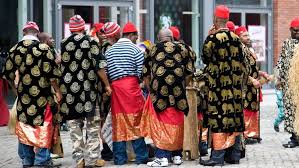
By Nwankwo T. Nwaezeigwe, PhD
In the last part, we were able to establish the origins of the words “Ado” and “Benin”, and subsequently confirmed that the word “Edo” was a British colonial term coined from “Ado” by the British colonial anthropologist Northcote W. Thomas. In other words, while “Ado” remains the traditional name of Bini and the Capital City, “Ubuni”, which was adopted by the Portuguese from the Itsekiri and, consequently corrupted to suit their pronunciation, soon became the popular identity of the people, their city and, their Kingdom.
From the last part equally, we were not only able to identify some earliest Igbo-Mokun Igbo settlements west of the Niger but affirmed the existence of three rival Benin Kingdoms, whose rivalry and subsequent wars of unification resulted to massive migrations eastwards, northwards and, southwards, as confirmed by traditions of origin, migration and settlement by most Esan communities to the north, Urhobo and Isoko, including some Ijon communities to the south, and some Anioma communities to the east.
Finally, we concluded the last part by revealing that up to the end of 15th and even towards the end of the 16th century, Benin Kingdom was spilt into three rival kingdoms. These kingdoms included the core Igodomigodo Kingdom with its center at the present site of Benin City, which the Eweka dynasty inherited; the Udo Kingdom to the northeast of Benin City which had been a rival center of power with the Igbodomigodo kingdom long before the emergence of Eweka dynasty; and the Idu Kingdom of Ugu west of Benin City, which was created out of the new Eweka dynasty in the early part of its reigns.
However, before venturing into a brief look at the three kingdoms, we have to look at what the neighbors of Benin Kingdom were called during the era of earliest written records which coincides with the Portuguese period. It is important at this stage to point out that the term “Igbo” as an ethnic group never existed among the neighbors of the Benin Kingdom of the period; even though the Bini’s traditional term for Igbo-speaking people among them remains “Ika.”
In some instances, the Bini also refer to the people of Ndokwa and Ndosimili as Oru. To state the obvious fact therefore, Anioma people were never known among Edo people as “Igbo” or “Ndi-Igbo” but either Ika or Oru people. The idea of one common Igbo identity based on common language was indeed a British colonial creation.
That was how the term “Ika-Ibo” was derived by the British Colonial administration as reference to the Igbo of West Niger. Thus, the word “Ika” is not an exclusive identity of the people referred to today as Ika sub-group of Delta and Edo States. Indeed, the people who are referred to as Ika proper today, refer to their kinsmen eastwards— Aniocha and Oshimili Local Government Areas as “Ndi Uzo-Igbo”, while the latter refer to them as “Ndi Uzo Ihu.” Daryll Forde and G. I. Jones in their classification of Western Igbo sub-group defined them as Northern Ika, Southern Ika and, Riverain.
The Northern Ika is made up of the present Aniocha North, Aniocha South, Oshimili North, Oshimili South, Ika Northeast and, Ika South Local Government Areas, including Onitha and Ogbaru. The Southern Ika on the other hand, is made up of the present Ndokwa West and Ukwuani Local Government Areas. The Riverain sub-group includes the present Ndokwa East Local Government Areas of Delta State; Onitsha North, Onitsha South and, Ogbaru Local Government Areas of Anambra State, including the Anam group of Villages with Nzam at the head; and the three Local Government Areas of Ahaoda East, Ahaoda West and, Ogba/Egbema/Ndoni in Rivers State.
As neighbors of Benin Kingdom, the West Niger Igbo people have no sharp ethno-linguistic boundary with the Edo, especially along the Agbor-Benin City axis, where Ika-speaking communities live in interspersed form with their Edo-speaking counterparts. For instance, many communities defined today as Edo in ethnic terms are indeed historical Ika-speaking communities, who chose to identify themselves as Edo; in the same way many historical Bini, Esan and Olukwumi communities among Anioma people chose to identify themselves as Igbo.
For the instruction of those who might not know, Ika-speaking communities in Edo State include: Ekpon, Igbanke, Owanikeke, Owa-Riuzo Idu, Igbogili, Ugo, Ute-Ohenze, Owa-Ute, Obagie N’Oheze, Oghada, Ogan, Otobaye, Ogba, Ebohighai, Urhonigbe, Urhomehe and, Idumwagbor, among others.
Strikingly enough, most, if not all, of these towns and villages, do not claim origin from Southeast Igboland, which goes to validate the Igbo-Mokun thesis of their Ile-Ife origins. This further explains why early European visitors to Benin Kingdom, notably the Portuguese, Dutch and English could not identify the present Anioma people as Igbo.
The earliest written information concerning the eastern border of the Benin Kingdom was that of the Portuguese traveller Duarte Pacheco Pereira recorded in his famous manuscript Esmeraldo De Situ Orbis, written according to Jaime Cortesao between 1505 and 1508. In his account on the location of Benin City, Pacheco Pereira wrote:
Beyond the Rio Primeiro is the Rio Fermoso [Benin/Ethiope River]; they lie NW and SE and occupy five leagues of the route…. A league up this river on the left, two tributaries enter the main stream: if you ascend the second of these four for twelve leagues you find a town called Huguatoo, of some 2,000 inhabitants; this is the harbour of the great city of Beny, which lies nine leagues in the interior with a good road [between them]. Small ships of fifty tons can go as far as Huguatoo. This city ia about a league long from gate to gate; it has no wall but is surrounded by a large moat, very wide and deep, which suffices for its defence. I was there four times. Its houses are made of mud-walls covered with palm leaves.
Pereira went further to state that the Kingdom of Beny [Benin] was constantly at war with her neighbors who were taken as captives and sold to them [Portuguese] for 12 brass bracelets for one, or 15 copper bracelets, which they resold at the Castle of S. Jorze da Mina [El Mina Castle, Ghana]. On the nations bordering Benin Kingdom to the east, Pereira wrote:
A hundred league to the east of this Kingdom of Beny in the interior we know of a land which in our time has a king called Licosaguou; he is said to be lord of many peoples and very powerful. Close by is another great lord of the name of Hooguanee, who among the negroes is as the Pope among us…. In the mountains and woods of this region dwell savage men whom the negroes of Beny call “oosaa.” They are very strong and are covered with bristles like pigs; their nature is entirely human except that instead of speaking they shout…. A hundred leagues upstream towards the source of Rio Fermoso is negro country called Opuu.
On the southern border of Benin Kingdom, Pereira continued:
Five leagues beyond Rio dos Escravos is another river called Rio dos Forcados; its name is due to the fact that when it was discovered many birds were found there with tails forked like those of swallows…. The inhabitants along this river are called Huela. Further in the interior is another country called Subou…. Beyond these dwell other negroes called Joss, who own a large country; they are warlike people and cannibals.
From the foregoing, there is no doubt about the identity of the Urhobo [Subou] and Ijon [jos]. The Huela from the description of their location were no doubt the present Itsekiri which the later Dutch traveler Landolphe described as Owhere [Warri]. “Hooguanee” could as well mean the Ooni of Ife as suggested by Ling Roth. But the major riddles before us and which Ling Roth could not solve were the great king called Licosaguou which he referred to as “Likasagu”, Oosaa which he calls “Oza”, and the Opuu which he calls “Opu”, all dwelling east of the Benin Kingdom.
Regarding, the King Licosaguou, it could have been plausible to associate him with the Akpoto Kingdom of Igala given the distance mentioned, but Idah is not east of Benin City, but Northeast. Again, if we consider the Idu Kingdom of Ugu situated east of Benin, the distance again raises some problems; unless we decide to see it as an acceptable margin of locational error between Ile-Ife which was far from Benin City and Idu Kingdom of Ugu which was nearer to Benin City.
And indeed, there is no historical account, especially the kind before us without such margin of error. So, it is probable that the said King Licosaguou was that of the Eastern Benin Kingdom of Ugu, popularly known as Idu among the Igbo of the West Niger, while Hooguanee was the Ooni of Ife.
Similarly, we are inclined to believe that Pereira’s Opuu people were indeed the ancestors of the present Anioma people, made up of the original settlers from Igbo-Mokun Ile-Ife. We accept the probability of this fact on two grounds. The first ground is the location of these people up-stream towards the source of Rio Fermoso (River Ethiope), which coincides with the present Ndokwa-Aniocha-Ika-Bini meeting-point axis.
Strikingly enough, the Ethiope River which has its source at the town of Umuaja in Ukwuani Local Government Area of Delta State forms the spiritual radiating point of the Ethiope River Deity commonly called Onoku (Olokun) by Anioma, Bini and, Urhobo, all of whom share the same spiritual value and form of worship for the deity. Indeed, for Bini people, Olokun deity originated from the town Urhonigbe which is situated within the Ethiope source axis. According to Matthew Omoruyi Otasowie, writing for the people of the town of Ugo:
Edo mythology says, Olokun was the son of Osanobua, the supreme deity, However, to the people of Ugo, Olokun has been conceived as the deity of Urhonigbe, ‘Olokun nu Urhonigbe’. Ugo people believe that Olokun originated from Urhonigbe river. Urhonigbe river has been referred to as Eze-Olokun.
Ese Odokuma further confirmed:
The Benin shrine dedicated to Olokun is located in two major areas namely: Urhionigbe and Evboise in Edo State, although of course many more sites exist. The Urhionigbe Site is sandwiched between two Delta areas of Umutu (Ndokwa) and Abavo (Ika south), all in Delta State. These areas also have large representations of Onoku(Olokun). Olokun in Evboise was said to have originated from Ethiope river in Delta State.
The above assertions not only suggest the Igbo origin of Olokun deity among the Bini, probably brought from Igbo-Mokun (Ile-Ife) but contradicts the position of Professor Bernard I. Belasco, which was equally adopted by Professor Robert Arthur Sargent that the idea of Olokun worship was introduced by Oba Ohen. If Urhonigbe is considered by Benin tradition as the originator of Olokun deity, then there wouldn’t have been any other source outside the Ethiope River which she is associated with.
Moreover, the term “Eze-Olokun” clearly suggests its Igbo root. Most importantly is the fact that Umuaja tradition only speaks of the discovery of the source of the Ethiope and not the Onoku (Olokun) Deity, which presupposes that the worship might have belonged to earlier-than Umukwata settlement.
The second ground is predicated on the existence of an aboriginal group named Opu (Umu-Opu Quarters) in the present town of Akwukwu-Igbo in Oshimili North Local Government Area of Delta State. So we can rightly infer that the original inhabitants of the present Anioma land were once known as Opu. It is therefore probable that the idea of Olokun was associated with these Opu aborigines of Igbo-Mokun (Ile-Ife) who fled eastwards after Oduduwa’s conquest.
However, we cannot adequately fix out those referred to by Pereira as Oosaa, which Ling Roth referred to as Oza. Here the question might arise, was he referring to the descendants of the present Oza-Nogogo, whose settlement on their present abode predated their now dominant Agbor Kingdom? Was the hill mentioned by Pereira the Orhionmwon River slope on which the community is situated? These questions one believes would form the basis of further research on the history of Anioma people. Ironically, the title of the traditional ruler of Oza-Nogogo is “Ogisi” which appears to sound like a corruption of the pre- Eweka dynastic Bini title of Ogiso.
Be that as it may, from the foregoing, we have arrived at two key facts. The first is that the present people of Anioma or West Niger Igbo as they are generally referred to by historians, were never referred to as Igbo, but Ika, or Oru for mostly Ndokwa and Ndosimili people, by their Bini (Edo) neighbors. The generic name for Anioma people was Ika, hence the initial use of the term “Ika-Ibo” by the British Colonial administration to describe the present Anioma people.
The second fact is that, in addition to the main Ado Kingdom centered in Benin City, and the Udo Kingdom situated northwest of Benin City, there was also an already existing powerful Benin kingdom situated east of the present Benin City at the time of Duarte Pacheco Pereira, coinciding with late 15th to early 16th century, which was independent of the main Benin Kingdom situated at Benin City.
These three Kingdoms coincide today with the three traditional geo-political structures of the Benin Kingdom—the core Benin/Ado/Igodomigodo made up of the present Oredo, Ikpoba-Okha and Egor Local Government Areas; Iyekovia with Udo as the revolving center made up of Ovia North-East and Ovia South-West Local Government Areas; and Idu kingdom of Iyekorhionmwon popularly known as Ugu Kingdom made up of the two Local Government Areas of Orhionmwon and Uhunmwonde.
However, we are mostly concerned here with the Idu Kingdom of Ugu, from which it appears, much of the later migrations to the present Anioma took place. Although, as Professor Robert Sargent rightly put it, up to the early period of the Eweka dynasty Benin Kingdom remained largely mixed Igbo and Bini, not much about Igbo migrations from the Udo kingdom eastwards was recorded.
In fact, only the foundation of Agbor was vividly connected with accounts of Igbo migration from Udo following the unification wars against Udo by Oba Ewedo. According to Sargent stated:
Agbor was apparently founded in a migration of Igbo-speakers from Udo in c.1401-1428 under the leadership of Dein. Dein forced various desperate groups around Agbor to recognize, at least nominally, his authority and thereafter enabled his son Igbudu, to establish a powerful Igbo-dominated polity. It is certainly interesting that the migration from Udo occurred as Oba Ewedo was instituting the more coercive and exploitative regime of the tributary social formation.
Interestingly, of the three Kingdoms, the Idu Kingdom of Ugu is the least studied, probably arising from the manner in which it went into extinction. This was because unlike the Udo-based Iyekeovia Kingdom, the Idu Kingdom of Ugu never engaged in long-drawn wars with the central Ado Kingdom of Benin. Its origin also appears to lack concise historical definition. Indeed, Professor Osadolor in his analysis of the origin of the kingdom presents us with three versions of its origin, all appearing plausible in their respective rights.
In one version he presented us with the impression that the kingdom existed as a rival kingdom during the Ogiso era long before Eweka dynasty, which was unified with the Ado Kingdom of Igodomigodo by the war-like Ogiso Odoligie without war, against the case of the Kingdom of Udo which came under Ado control after protracted wars leading to its eventual defeat. From this version we are made to understand that the Idu Kingdom of Ugu was created during the era of weak rulers of the Ogiso dynasty.
This version clearly lends meaning to the second version which links the formation of the kingdom to the first son of Oba Eweka named Idu, who was denied the right to succeed his father. He was subsequently compensated with the Ugu Kingdom of Iyekorhionmwon, which later adopted his name “Idu”, as the Ika reference to Benin Kingdom. Narrating this version, Professor Osadolor wrote:
The foundation of the kingdom of Ugu, with its capital at Umoghumwun has been traced to prince Idu, the eldest son of Oba Eweka I. The Uzama who regulated and succession to the throne did not accept Prince Idu as successor to the throne but favoured his younger brother Prince Uwakhuahen…. After Uwakhuahen was crowned Oba, Prince Idu protested vigorously the attitude of the Benin elders towards him, and threatened to declare war. He had the sympathy of his mother’s people and most elders in Iyehorhionmwon, who also vowed to go to war to avenge the injustice. Benin elders were panic-struck, and “to appease Prince Idu, the kingdom was divided.” The whole of south east was ceded to him. This was how the kingdom of Ugu was founded. Because the people were very warlike, the kingdom of Ugu rivaled Benin.
The third version links the origin of the kingdom to the crisis arising from the succession dispute between Ogiso Ogiamien and Oba Ewedo which ended with the victory of the latter at the Battle of Ekiokpagha in c.1255AD. According to Professor Osadolor:
At the time of this victory, the kingdom of Benin had disintegrated into three mini states, each with its ruling dynasty. Benin kingdom under Ewedo was limited in territory to Benin City, its immediate neighbourhood, and villages in the north east and Iyekuselu. The second kingdom which was known as the Kingdom of Ugu emerged in Iyekorhionmwon, in the south east. Benin City was some seven kilometres from the borders of the new kingdom and its southernmost limits terminated at the River Ethiope. The king was known as the Oba N’Ugu (king of Ugu).
We are however not concerned about which of the three versions is most probable. Our point of argument is predicated on the possible existence of another rival Benin kingdom west of Benin City and, since the three versions acknowledge such existence, the trajectory of their narratives notwithstanding, we are therefore factually convinced. Professor Osadolor has further told us that Idu Kingdom of Ugu lasted till the late 16th century when it was finally conquered and unified with the parent Ado Kingdom at Benin City under Oba Ehengbuda.
From the forgoing, we are made to understand that the concept of “Ado na Idu” often applied in reference to the pre-colonial Benin Kingdom by the West Niger Igbo (Anioma) rightly means the two kingdoms of Ado in Benin City and the Idu Kingdom of Ugu. The term also continued to be used in reference to both kingdoms after unification. The use of the term “Ado na Idu” in Ezechime tradition of origin, migration and, settlement is therefore historically correct.
Although the unification war that brought the Idu Kingdom of Ugu under the Ado Kingdom might have led to the movement of refugees north into the Esan territory, east and southeast into Western Igbo and south into Urhobo land, it is unlikely that Ezechime and his followers might have been part of that phase of migration. The reason is connected with the later emergence of the town of Ugo as a revolving political center of pro-Benin Kingdom communities among the old Idu Kingdom of Ugu and, its powerful Onogie named Emokpaogbe, popularly known as “Agboghidi” in Bini and “Agbogidi” among the Ezechime Clan.
Matthew Otasowie writing on Ugo history gives us the following brief account of Agboghidi:
Many Enogies have ruled in Ugo traditional system, the one whose history was extant is Agboghidi, a principal figure in Benin oral tradition. His real name was given as Emokpaogbe, born to the Enogie of Ugo after having some daughters. He succeeded his father with the name Agboghidi. His reign was popularized by his engagement in two wars, first he led the Edo people to war against Oboro-uku. Second, he fought war against the superior king, Oba of Edoha, the battle that claimed his life.
Agboghidi was first used by Oba Ahengbuda to put remnants of the old Idu Kingdom of Ugu in check; thereafter he was engaged by the same Oba to fight the Obi of Ubulu-Uku for killing the daughter of the Ezomo of Benin Kingdom named Adesuwa for insulting and refusing to marry him. Before the war, Agboghidi was a close friend of the Obi of Ubulu-Uku who had helped to cure him of blindness; but he could not refuse the Oba’s orders. It was indeed during this war that some Ubulu-Uku people fled east of the Niger to found the present town of Ozubulu in Anambra State.
After defeating Ubulu-Uku town, Agboghidi returned, and for whatever reason revolted against the Oba of Benin Kingdom, who subsequently defeated him, leading to his death. Many of his followers fled Ugo for fear of Oba’s retribution. Umuezechime appears to be part of his prominent followers who could face instant death penalty from the Oba, hence their decision to flee eastwards.
With the old relationship between Agboghidi and Obi of Ubulu-Uku in mind, Umuezechime’s first port of call for refuge became the present town of Obior which shares common border with the Kingdom of Ubulu-Uku. It was indeed from Obior that the Umuezechime immigrants dispersed to found the group of towns known today as Umuezechime Clan. This again suffices to explain why Obior is regarded as the head of Umuezechime Clan.
It also appears that it was in honor of Agboghidi that the Kings of Ezechime Clan decided to adopt the honorific title of “Agbogidi”, which remains exclusive to them. So far, there is no historical tradition or evidence that traces the origin of Agboghidi (Agbogidi) to somewhere else outside the Agboghidi of Ugo in Edo State.
Then again, the question of the true identity of Eze Chime might arise at this point. Was Eze Chime (King Chime) another reference to Agboghidi, since up till today the town of Ugo remains bilingual (Bini and Ika-Igbo), and especially with the obvious correlation of Umuezechime tradition of origin, migration and settlement with the tradition of Agboghidi’s conflict with Oba Ehengbude? The possibility of Agboghidi being the Eze Chime of Umuezechime tradition appearing plausible seems certain because of the closeness of the correlated events in both Ezechime and Ugo traditions.
It is therefore right to state ipso facto that the actual point of Ezechime’s migration was Ugo which is both a de facto and de jure Bini town, even though bilingual to some extent. The Umuezechime Clan’s claim of being Benin origin, or having migrated from Ado na Idu cannot therefore be faulted in history. Here again the question of language and ethnic identity arises, which in turn gives rise to the question of Anioma identity. The fundamental question before us right now as we move to the concluding pat is: Who are Anioma people?
Dr. Nwankwo T. Nwaezeigwe is the Odogwu Ibusa & President, International Coalition against Christian Genocide in Nigeria (ICAC-GEN). He was formerly Director, Centre for Igbo Studies, University of Nigeria, Nsukka. He lives in exile in Manila, Republic of the Philippines.

